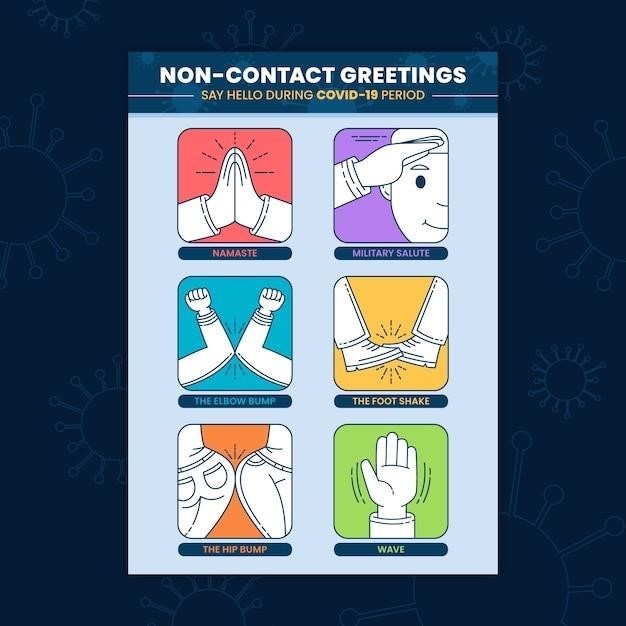
church usher hand signals pdf
Church Usher Hand Signals⁚ A Comprehensive Guide
This guide provides a detailed overview of church usher hand signals, including the National Silent Uniform System, common signals and their meanings, variations across denominations, and printable resources․ Learn effective communication strategies beyond hand signals for improved teamwork and service․
The National Silent Uniform System
The National Silent Uniform System, developed in the 1940s by George T․ Grier, is a standardized set of hand signals used by church ushers for discreet communication during services․ This system, still taught by the National United Church Ushers Association of America, ensures consistent and efficient service․ The system’s core principle is silent communication, minimizing disruptions to the worship experience․ While variations exist across denominations, the core signals remain largely consistent․ The resting position typically involves one hand at the side and the other fisted at the back․ Specific hand positions convey various messages, such as indicating available seating, the need for assistance, or signaling the start of an offering․ These signals are crucial for maintaining order and providing seamless assistance to congregants throughout the service․ The system’s continued use highlights its enduring value in facilitating smooth and respectful church services․ Detailed diagrams and explanations of these signals are often available in printable resources or training materials․ The goal is a unified, non-verbal approach to ushering, improving the overall worship experience․
Common Hand Signals and Their Meanings
While specific hand signals can vary slightly between churches and denominations, several common gestures consistently appear in church ushering․ A raised hand with a closed fist often signifies a request for available seating․ The number of fingers extended usually corresponds to the number of seats needed․ An open hand often indicates a greeting or acknowledgment․ A hand pointed downwards might signal a need for assistance or a specific direction․ Ushers often use a cupped hand under the waist as a “service position,” a neutral posture while awaiting instructions․ A signal for prayer might involve crossing arms, each hand touching the opposite elbow․ These are simplified examples; some systems use more complex gestures or combinations․ The ‘receive and pass’ signal often involves extending the right hand to receive something, then passing it along․ A thumping chest might communicate distress or a need for immediate attention․ Understanding these common signals enhances communication among ushers and allows for efficient service during church services․ Comprehensive guides and printable resources often detail these hand signals with illustrative diagrams for clarity and ease of learning․
Variations in Hand Signal Usage Across Denominations
Although a standardized system like the National Silent Uniform System exists, variations in hand signal usage across different Christian denominations are common․ The specific gestures employed and their meanings can differ based on the church’s traditions, size, and the usher team’s preferences․ Some denominations might favor more subtle signals, while others might use more expressive hand movements․ For instance, the signal for starting or ending a prayer might vary; some churches might use a simple hand gesture, while others might incorporate a more formal bow or other accompanying movements․ The way offerings are handled can also differ, leading to unique signaling for collection procedures․ Furthermore, the level of formality in the service itself often impacts the style of communication used by ushers․ Smaller, less formal churches might rely less on a structured system of hand signals, opting instead for verbal communication or more intuitive cues․ Understanding these denominational differences is essential for ushers working in diverse church settings․ Adaptability and familiarity with a range of communication styles are vital for effective ushering across different religious contexts․

Printable Resources for Church Ushers
The accessibility of printable resources significantly enhances the training and efficiency of church ushers․ A well-designed printable guide can serve as a quick reference for hand signals, offering a visual aid readily available during services․ Such a resource could include clear images of each hand signal, accompanied by concise descriptions of their meanings․ Furthermore, a printable checklist can help ushers prepare for their duties, ensuring they have all the necessary materials before the service begins․ This could include items like bulletins, offering baskets, and any other relevant supplies․ Including a section on emergency procedures within the printable resource is also beneficial, providing clear instructions on how to handle unforeseen situations, such as medical emergencies or disruptive behavior․ Finally, a printable guide can be customized to reflect the specific needs and practices of a particular church or denomination, further enhancing its effectiveness․ The creation and distribution of these printable resources help standardize communication and ensure smooth, efficient service within the church community․ They also serve as an excellent training tool for new ushers, fostering a consistent approach to ushering duties․
Training and Resources for Effective Usher Communication
Effective communication training for church ushers is paramount for a seamless and welcoming church experience․ Comprehensive training should encompass not only the hand signal system, but also verbal communication skills, active listening techniques, and the importance of nonverbal cues․ Role-playing scenarios can simulate real-life situations, allowing ushers to practice greeting congregants, assisting with seating, and handling unexpected events․ Videos demonstrating proper hand signals and effective communication strategies can serve as valuable visual aids, reinforcing the training points․ Access to online resources and downloadable materials, such as PDFs of the hand signal system, further supports continuous learning and reference․ Regular refresher training sessions keep ushers updated on best practices and address any emerging challenges․ The training should also emphasize teamwork and collaboration, reinforcing the importance of clear communication between ushers to ensure a coordinated and efficient service․ Additionally, providing resources that address cultural sensitivity and inclusivity ensures a welcoming environment for all congregants․ By investing in comprehensive training and readily available resources, churches can empower their ushers to excel in their roles and contribute significantly to the overall church atmosphere․

Beyond Hand Signals⁚ Effective Usher Communication
Effective ushering involves more than just hand signals․ Verbal communication, body language, teamwork, and a welcoming demeanor are crucial for creating a positive church experience․ Additional resources can enhance these skills․
Verbal Communication and Body Language
While hand signals provide a discreet method of communication among ushers, verbal communication and body language play equally vital roles in creating a welcoming and efficient church experience․ Clear and concise verbal instructions, delivered with a warm and friendly tone, are essential for guiding congregants to their seats and answering their questions․ A welcoming smile and open posture can immediately put visitors at ease, creating a positive first impression of the church community․ Active listening is also crucial; paying attention to verbal cues and nonverbal signals from congregants allows ushers to effectively address concerns and provide assistance․ The ability to adapt communication styles to different individuals is essential, as is maintaining a respectful and professional demeanor at all times․ Careful consideration of these factors enhances the overall effectiveness of ushering services and contributes to a positive and inclusive worship environment․ Remember, a warm smile and a helpful attitude can go a long way in making congregants feel welcome and comfortable․
The Importance of Teamwork and Collaboration
Effective ushering relies heavily on seamless teamwork and collaboration․ Ushers function as a cohesive unit, their actions coordinated to ensure a smooth and efficient flow of services․ Prior to services, a brief meeting allows for the team to review the day’s schedule, discuss any special arrangements, and clarify roles and responsibilities․ Open communication during the service is crucial; clear hand signals and quick, silent exchanges ensure that requests for assistance are met promptly and discreetly without disrupting the worship experience․ After services, a debriefing session provides an opportunity to share feedback, address any challenges encountered, and make adjustments for future services․ Teamwork fosters a sense of camaraderie and shared responsibility, leading to a more harmonious and productive working environment․ A well-coordinated team creates a positive and welcoming atmosphere for congregants, leaving a lasting impression of efficiency and organization․ This collaborative spirit translates to a more effective and enjoyable experience for both the ushers and the congregation․
Additional Resources and Further Reading
For those seeking to expand their knowledge of church ushering and communication techniques, several valuable resources are available․ The National United Church Ushers Association of America, if still active, may offer training materials and guides, potentially including downloadable PDFs on hand signals and best practices․ Online searches for “church usher training manuals” or “effective church usher communication” may yield helpful articles and blog posts from ministry websites and leadership resources․ Books on church administration and volunteer management might contain relevant chapters on ushering protocols․ Videos showcasing usher training sessions from various churches could offer visual examples of hand signals and teamwork in action․ Remember to critically evaluate the source’s credibility and relevance to your specific needs․ Exploring these various resources can provide a more comprehensive understanding of ushering roles, communication strategies, and the overall contribution of ushers to a positive worship experience․ This continued learning ensures the consistent improvement of service and fosters a welcoming atmosphere for all․
Related Posts

pdf to ofx converter online free
Easily convert PDF files to OFX format online for free. No registration required, fast and secure conversion.

tu zona crypto book pdf
Dive into the world of cryptocurrency with our expert guide. Discover tips, tricks, and strategies for success in crypto trading and investing.

cronicas de una muerte anunciada pdf
Get the full “Cronicas de una Muerte Anunciada” book in PDF format instantly. Free download available now at mojopet.com.